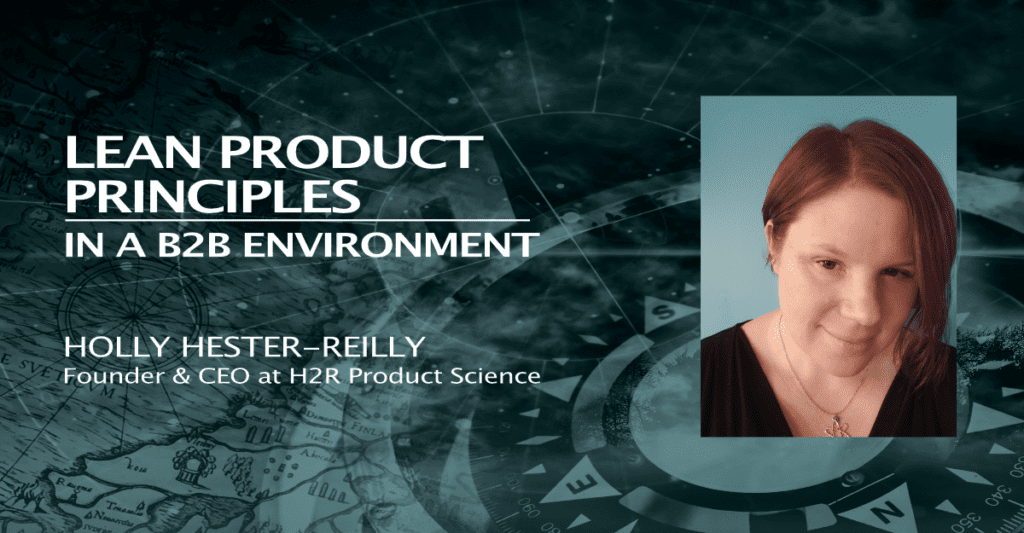Holly Hester-Reilly offers a briefing on how to apply continuous product discovery and lean product principles in a B2B environment.
Holly Hester-Reilly: Lean Product Principles in B2B

Driving towards evidence-based decisions using Product Science
How do you apply continuous product discovery and lean product principles in a B2B environment?
While the core methodology remains, a number of differences in a B2B setting require tailoring our practices. Holly Hester-Reilly shares her approach to:
- Collaborating with sales/marketing teams to gain access to customers
- Implementing lean discovery practices for the multiple roles involved in the buying process
- Drawing evidence-based conclusions despite a harder-to-reach set of customers and/or smaller pool of users
- Responding to product requests from key clients
Continuous discovery for better decisions
In the short video, below Holly makes the case for continuous discovery and highlights some common challenges.
Prioritize risks
Holly encourages us to start small and share the value. She shared practical insights on talking about and focusing on project risk. She shares a number of useful examples.
Diving into discovery research
Holly outlines her basic steps and approaches with a number of practical examples.
Full video
About Holly Hester-Reilly
Holly Hester-Reilly is the Founder and CEO of H2R Product Science (@H2RProductSci), a product management coaching and consulting firm that teaches the science of high-growth product development, and the host of the Product Science Podcast. Holly is a former Columbia University research scientist and has spent the last 15 years leading product initiatives at startups, high-growth companies, and enterprises like FalconX, MediaMath, Shutterstock, The Lean Startup Co, Unilever, Capital One, and Weight Watchers.
Holly also teaches at NYU Stern School of Business as well as public and private workshops and has spoken about building high-growth products for events such as Lean Startup Summit Europe, the Women in Product Annual Conference, ITX Product + Design Conf, Parsons School of Design, and INDUSTRY: The Product Conference.
Deck: Lean Product Principles in B2B [PDF]
SKMurphy Take
Holly provided a practitioners perspective on the practical realities executing continuous product discovery in a B2B market. She made a number of observations that resonated with me:
- “There is more to launching a successful product than frequent software releases.”
- “Continuous learning means you make adjustments as you go.”
- I am passionate about making a better product: I want to build a product people will love.
- To address executive concerns about the value of research: “we use research to fine tune our approach to implement your strategy because it’s cheaper and faster than building the full product.”
- “B2B tends to be a committee decision where there are choosers, users, and gatekeepers map the decision making process, and make sure you include all of the relevant roles in research plan.”
- “As you evaluate research findings, if a coherent picture emerging then you are getting close to done. If the answers discordant you need to dig in.”
I was impressed how she leveraged a pre-mortem process (assume product has failed and determine what risks were the most likely cause of failure) to drive research:
- Part 1: Brainstorm ways that the product may fail
- Usability Failure: What are the trickiest parts to design?
- Feasibility Failure: What is least understood about how to build this?
- Value Failure: Even if we built everything we envision, why would users/buyers not buy this?
- Viability Failure: Why might this not meet the business goals?
- Ethics Failure: Why might this be ethically risky?
- Part 2: Assess likelihood and impact and plot each risk in those two dimensions
- Likelihood: how likely is it that this will happen?
- Impact: How strongly would it impact success if it did happen?
Use these risks to drive your research agenda: what decisions do we need to make soon and what are our riskiest assumptions?
Related Blog Posts
- Qualitative Research: Problem Exploration for Lean Startups
- John Nash on “Make Something that People Want”
- David Telleen-Lawton on Customer Discovery Meetings at Lean Culture Tue-Jun-26-2018
- Book Club: Traversing the Traction Gap by Bruce Cleveland
- Etienne Garbugli on Opportunities: Finding New Products
- Market Discovery and Exploration Requires Models from Physics, Biology, and Psychology
- Landing Your First Ten Customers: Videos, Slides, and Other Resources
- How To Scale Up Qualitative Research Efforts
- Innovation Inside an Organization Requires Balancing Priorities
- 40 Tips for B2B Customer Development Interviews
